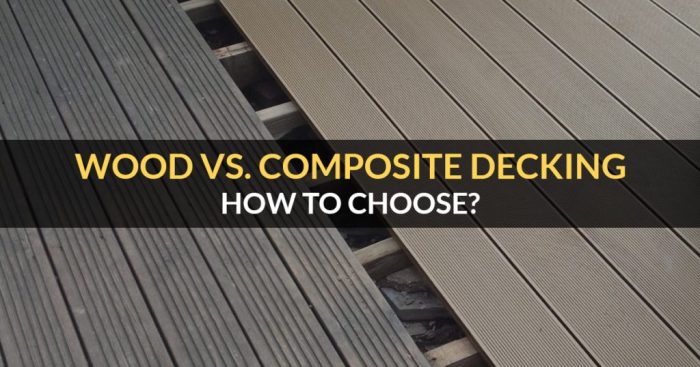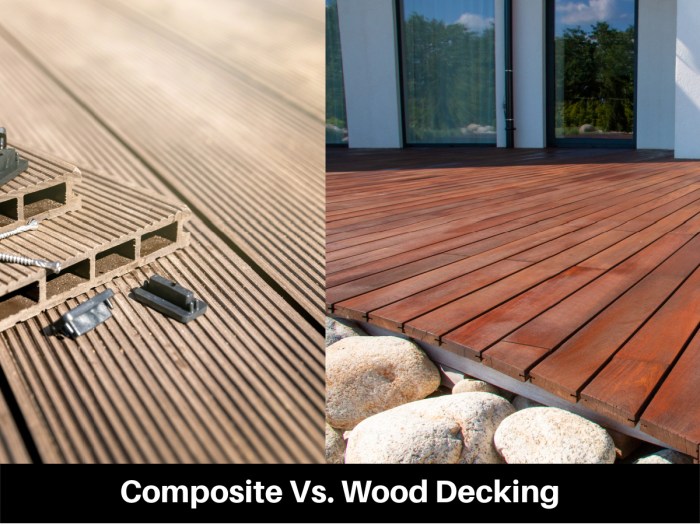Composite vs Wood Decking: Choosing the Best Material for Your Outdoor Space
When deciding between composite and wood decking, it's essential to understand the key differences in materials and the impact on durability and maintenance. This comprehensive guide will help you navigate the pros and cons of each material, allowing you to make an informed decision for your outdoor living space.
As we delve deeper into the comparison between composite and wood decking, you'll gain valuable insights into the installation process, cost analysis, aesthetics, and design options available for both materials. Let's explore the world of decking materials together.
Composite Decking vs. Wood Decking
When it comes to choosing between composite decking and wood decking, there are several factors to consider. Let's explore the key differences between the two options.
Materials Used
Composite decking is made from a combination of wood fibers and recycled plastic materials, offering a more sustainable and eco-friendly option compared to traditional wood decking. On the other hand, wood decking is typically made from natural wood, such as cedar, pressure-treated lumber, or tropical hardwoods.
Durability
Composite decking tends to be more durable and long-lasting than wood decking. It is resistant to rot, mold, and insects, making it a low-maintenance option for outdoor spaces. Wood decking, on the other hand, may require regular maintenance, such as sealing, staining, and treating to prevent decay and damage.
Maintenance Requirements
Composite decking requires minimal maintenance, as it does not need to be stained or sealed like wood decking. Simply cleaning with soap and water is usually sufficient to keep composite decking looking new. Wood decking, however, requires regular maintenance to protect it from the elements and extend its lifespan.
Environmental Impact
Choosing composite decking over wood decking can have a positive environmental impact. Composite decking uses recycled materials, reducing the demand for virgin wood and plastic. Additionally, composite decking does not require chemical treatments or sealants that can be harmful to the environment.
Overall, composite decking is a more sustainable choice for environmentally-conscious homeowners.
Installation Process

When it comes to installing decking, whether composite or wood, the process can be a crucial factor in determining which material is the best fit for your project. Let's explore the steps involved in installing composite decking, the tools required for installing wood decking, compare the ease of installation between the two, and provide tips for a successful installation of both.
Composite Decking Installation
Installing composite decking involves the following steps:
- Prepare the substructure: Ensure the frame is sturdy and level.
- Start with the first board: Begin by securing the first board with clips or screws.
- Continue with subsequent boards: Install each board, ensuring proper spacing.
- Complete the installation: Trim any excess material and add finishing touches.
Tools for Wood Decking Installation
To install wood decking, you will need the following tools:
- Power drill
- Circular saw
- Hammer
- Tape measure
- Level
Comparing Ease of Installation
When comparing the ease of installation between composite and wood decking, composite decking is often considered easier to install due to its uniformity and lighter weight. Wood decking may require more effort and precision, especially when cutting and aligning the boards.
Tips for Successful Installation
Here are some tips for a successful installation of both composite and wood decking:
- Follow manufacturer guidelines for installation.
- Use appropriate fasteners to prevent buckling or warping.
- Allow for proper ventilation and drainage to prevent moisture buildup.
- Regularly maintain and inspect the decking to ensure longevity.
Cost Analysis
Composite decking may have a higher initial cost compared to wood decking, but the long-term expenses can vary significantly. Let's break down the cost analysis to understand the financial implications of choosing between composite and wood decking.
Initial Costs
When it comes to initial costs, composite decking materials are generally more expensive than wood. The price of composite boards can range from $3 to $7 per square foot, while wood decking materials typically cost between $1 to $5 per square foot.
The difference in cost is primarily due to the higher quality and durability of composite materials.
Long-Term Costs
While the initial investment in composite decking may be higher, the long-term costs can be lower compared to wood decking. Composite boards require less maintenance, such as sealing, staining, or painting, which can add up over the years for wood decking.
Additionally, composite decking is more resistant to rot, mold, and insect damage, reducing the need for costly repairs or replacements.
Factors Affecting Wood Decking Costs
The overall cost of maintaining wood decking can be influenced by various factors, such as the type of wood used, maintenance requirements, and the climate in which the deck is located. Hardwood decking, like cedar or redwood, may have higher upfront costs but can last longer with proper care.
However, softwood decking, such as pine, may require more frequent maintenance and replacements, increasing the long-term expenses.
Cost-Effectiveness Comparison
In the long run, choosing composite decking can be more cost-effective due to its durability and low maintenance requirements. While wood decking may have a lower initial cost, the ongoing expenses for maintenance and repairs can make it a more expensive option over time.
Consider your budget, lifestyle, and preferences to determine the most cost-effective choice between composite and wood decking for your outdoor space.
Aesthetics and Design
When it comes to the aesthetics and design of decking materials, both composite and wood options offer unique characteristics that can enhance outdoor spaces in different ways.
Composite Decking Aesthetic Options
Composite decking comes in a wide range of colors, textures, and finishes, offering homeowners plenty of choices to match their outdoor design preferences. From natural wood tones to modern grays and browns, composite decking can mimic the look of real wood while providing the durability of a synthetic material.
Natural Look and Feel of Wood Decking
Wood decking, on the other hand, boasts a classic and timeless appeal with its natural look and feel. The rich grains and warm tones of wood can create a cozy and inviting atmosphere in outdoor areas. While wood requires more maintenance compared to composite decking, many homeowners appreciate the authenticity and charm that wood brings to their outdoor space.
Versatility in Design Choices
Both composite and wood decking offer versatility in design choices. Homeowners can opt for traditional straight patterns or explore more intricate designs like herringbone or chevron patterns. Additionally, mixing different decking materials or incorporating contrasting colors can add visual interest and depth to outdoor spaces.
Enhancing Outdoor Spaces
To enhance outdoor spaces using composite decking, consider creating a seamless transition between indoor and outdoor areas by using the same decking material inside and outside. For wood decking, adding built-in seating, planters, or pergolas can elevate the overall look and functionality of the outdoor space.
Incorporating outdoor lighting, rugs, and furniture can further enhance the ambiance and usability of the deck.
Final Summary

In conclusion, whether you prioritize durability, cost-effectiveness, or aesthetic appeal, the choice between composite and wood decking ultimately depends on your preferences and priorities. By weighing the factors discussed in this guide, you'll be equipped to make the best decision for your outdoor oasis.
FAQ Section
Is composite decking more expensive than wood decking?
While composite decking typically has a higher upfront cost, it can be more cost-effective in the long run due to lower maintenance requirements and longevity.
How do I enhance the aesthetics of my outdoor space with wood decking?
You can enhance the natural beauty of wood decking by staining or painting it in different colors, adding outdoor furniture, and incorporating plants or lighting elements.
What tools are essential for installing composite decking?
Tools like a drill, saw, measuring tape, and composite deck screws are essential for installing composite decking efficiently and accurately.
What environmental factors should I consider when choosing between composite and wood decking?
Composite decking is often considered more environmentally friendly as it is made from recycled materials and requires less maintenance with chemicals that can harm the environment.